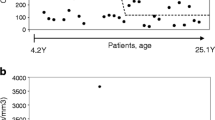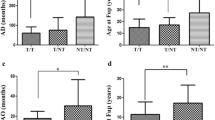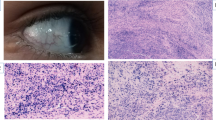Abstract
A nationwide survey was conducted for identifying ataxia-telangiectasia (AT) patients in Japan. Eighty-nine patients were diagnosed between 1971 and 2006. Detailed clinical and laboratory data of 64 patients including affected siblings were collected. Analyses focused on malignancy, therapy-related toxicity, infection, and hematological/immunological parameters. The phenotypic variability of AT was assessed by comparing 26 affected siblings from 13 families. Malignancy developed in 22% of the cases and was associated with a high rate of severe therapy-related complications: chemotherapy-related cardiac toxicity in 2 children, and severe hemorrhagic cystitis requiring surgery in 2 patients. The frequency of serious viral infections correlated with the T cell count. Hypogammaglobulinemia with hyper-IgM (HIGM) was recorded in 5 patients, and 3 patients developed panhypogammaglobulinemia. Differences in immunological parameters were noted in siblings. Four patients showed an HIGM phenotype, in contrast to their siblings with normal IgG and IgM levels. The patients with HIGM phenotype showed reduced levels of TRECs and CD27+CD20+ memory B cells. The findings suggest that hitherto unidentified modifier genes or exogenous environmental factors can influence the overall immune responses. Our data along with future prospective study will lead to better understanding of the hematological/immunological phenotypes and to better care of the patients.





Similar content being viewed by others
References
Claret Teruel G, Giner Munoz MT, Plaza Martin AM, Martin Mateos MA, Piquer Gibert M, Sierra Martinez JI. Variability of immunodeficiency associated with ataxia telangiectasia and clinical evolution in 12 affected patients. Pediatr Allergy Immunol. 2005;16:615–8.
Gatti RA. Ataxia-telangiectasia. In: Scriver CR, Beaudet AL, Sly WS, editors. Metabolic and molecular basis of inherited diseases. New York: Mcgraw-Hill; 2001. p. 1187–96.
Gatti RA, Becker-Catania S, Chun HH, Sun X, Mitui M, Lai CH, et al. The pathogenesis of ataxia-telangiectasia. Learning from a Rosetta Stone. Clin Rev Allergy Immunol. 2001;20:87–108.
Perlman S, Becker-Catania S, Gatti RA. Ataxia-telangiectasia: diagnosis and treatment. Semin Pediatr Neurol. 2003;10:173–82.
Cabana MD, Crawford TO, Winkelstein JA, Christensen JR, Lederman HM. Consequences of the delayed diagnosis of ataxia-telangiectasia. Pediatrics. 1998;102:98–100.
Moin M, Aghamohammadi A, Kouhi A, Tavassoli S, Rezaei N, Ghaffari SR, et al. Ataxia-telangiectasia in Iran: clinical and laboratory features of 104 patients. Pediatr Neurol. 2007;37:21–8.
Crawford TO, Skolasky RL, Fernandez R, Rosquist KJ, Lederman HM. Survival probability in ataxia telangiectasia. Arch Dis Child. 2006;91:610–1.
Nowak-Wegrzyn A, Crawford TO, Winkelstein JA, Carson KA, Lederman HM. Immunodeficiency and infections in ataxia-telangiectasia. J Pediatr. 2004;144:505–11.
Vacchio MS, Olaru A, Livak F, Hodes RJ. ATM deficiency impairs thymocyte maturation because of defective resolution of T cell receptor alpha locus coding end breaks. Proc Natl Acad Sci USA. 2007;104:6323–8.
Savitsky K, Bar-Shira A, Gilad S, Rotman G, Ziv Y, Vanagaite L, et al. A single ataxia telangiectasia gene with a product similar to PI-3 kinase. Science. 1995;268:1749–53.
Lange E, Borresen AL, Chen X, Chessa L, Chiplunkar S, Concannon P, et al. Localization of an ataxia-telangiectasia gene to an approximately 500-kb interval on chromosome 11q23.1: linkage analysis of 176 families by an international consortium. Am J Hum Genet. 1995;57:112–9.
Taylor AM, Byrd PJ. Molecular pathology of ataxia telangiectasia. J Clin Pathol. 2005;58:1009–15.
Shiloh Y. ATM and related protein kinases: safeguarding genome integrity. Nat Rev Cancer. 2003;3:155–68.
Shiloh Y. The ATM-mediated DNA-damage response: taking shape. Trends Biochem Sci. 2006;31:402–10.
Reliene R, Schiestl RH. Antioxidants suppress lymphoma and increase longevity in ATM-deficient mice. J Nutr. 2007;137:229S–32S.
Reliene R, Schiestl RH. Antioxidant N-acetyl cysteine reduces incidence and multiplicity of lymphoma in Atm deficient mice. DNA Repair (Amst). 2006;5:852–9.
Du L, Pollard JM, Gatti RA. Correction of prototypic ATM splicing mutations and aberrant ATM function with antisense morpholino oligonucleotides. Proc Natl Acad Sci USA. 2007;104:6007–12.
Lai CH, Chun HH, Nahas SA, Mitui M, Gamo KM, Du L, et al. Correction of ATM gene function by aminoglycoside-induced read-through of premature termination codons. Proc Natl Acad Sci USA. 2004;101:15676–81.
Oguchi K, Takagi M, Tsuchida R, Taya Y, Ito E, Isoyama K, et al. Missense mutation and defective function of ATM in a childhood acute leukemia patient with MLL gene rearrangement. Blood. 2003;101:3622–7.
Takagi M, Tsuchida R, Oguchi K, Shigeta T, Nakada S, Shimizu K, et al. Identification and characterization of polymorphic variations of the ataxia telangiectasia mutated (ATM) gene in childhood Hodgkin disease. Blood. 2004;103:283–90.
Gilad S, Chessa L, Khosravi R, Russell P, Galanty Y, Piane M, et al. Genotype-phenotype relationships in ataxia-telangiectasia and variants. Am J Hum Genet. 1998;62:551–61.
Birrell GW, Kneebone K, Nefedov M, Nefedova E, Jartsev MN, Mitsui M, et al. ATM mutations, haplotype analysis, and immunological status of Russian patients with ataxia telangiectasia. Hum Mutat. 2005;25:593.
Morio T, Hanissian S, Geha RS. Characterization of a 23-kDa protein associated with CD40. Proc Natl Acad Sci USA. 1995;92:11633–6.
Morio T, Hanissian SH, Bacharier LB, Teraoka H, Nonoyama S, Seki M, et al. Ku in the cytoplasm associates with CD40 in human B cells and translocates into the nucleus following incubation with IL-4 and anti-CD40 mAb. Immunity. 1999;11:339–48.
Morio T, Nagasawa M, Nonoyama S, Okawa H, Yata J. Phenotypic profile and functions of T cell receptor-gamma delta-bearing cells from patients with primary immunodeficiency syndrome. J Immunol. 1990;144:1270–5.
Al-Harthi L, Marchetti G, Steffens CM, Poulin J, Sekaly R, Landay A. Detection of T cell receptor circles (TRECs) as biomarkers for de novo T cell synthesis using a quantitative polymerase chain reaction-enzyme linked immunosorbent assay (PCR-ELISA). J Immunol Methods. 2000;237:187–97.
Suzuki K, Tsugawa K, Oki E, Morio T, Ito E, Tanaka H, et al. Vesical varices and telangiectasias in a patient with ataxia telangiectasia. Pediatric Nephrology. 2008;23:1005–8.
Giovannetti A, Mazzetta F, Caprini E, Aiuti A, Marziali M, Pierdominici M, et al. Skewed T-cell receptor repertoire, decreased thymic output, and predominance of terminally differentiated T cells in ataxia telangiectasia. Blood. 2002;100:4082–9.
Chun HH, Gatti RA. Ataxia-telangiectasia, an evolving phenotype. DNA Repair (Amst). 2004;3:1187–96.
Marshall FF, Klinefelter HF. Late hemorrhagic cystitis following low-dose cyclophosphamide therapy. Urology. 1979;14:573–5.
Stillwell TJ, Benson RC Jr. Cyclophosphamide-induced hemorrhagic cystitis. A review of 100 patients. Cancer. 1988;61:451–7.
Walker RD. Cyclophosphamide induced hemorrhagic cystitis. J Urol. 1999;161:1747.
Mizutani S. Genetic background as a possible determinant of clinical and biological features of Epstein-Barr virus infection—a hypothetical view. Crit Rev Oncol Hematol. 2002;44:217–25.
Pan Q, Petit-Frere C, Lahdesmaki A, Gregorek H, Chrzanowska KH, Hammarstrom L. Alternative end joining during switch recombination in patients with ataxia-telangiectasia. Eur J Immunol. 2002;32:1300–8.
Pan-Hammarstrom Q, Dai S, Zhao Y, van Dijk-Hard IF, Gatti RA, Borresen-Dale AL, et al. ATM is not required in somatic hypermutation of VH, but is involved in the introduction of mutations in the switch mu region. J Immunol. 2003;170:3707–16.
Pan-Hammarstrom Q, Lahdesmaki A, Zhao Y, Du L, Zhao Z, Wen S, et al. Disparate roles of ATR and ATM in immunoglobulin class switch recombination and somatic hypermutation. J Exp Med. 2006;203:99–110.
Peron S, Pan-Hammarstrom Q, Imai K, Du L, Taubenheim N, Sanal O, et al. A primary immunodeficiency characterized by defective immunoglobulin class switch recombination and impaired DNA repair. J Exp Med. 2007;204:1207–16.
Reina-San-Martin B, Chen J, Nussenzweig A, Nussenzweig MC. Enhanced intra-switch region recombination during immunoglobulin class switch recombination in 53BP1−/− B cells. Eur J Immunol. 2007;37:235–9.
Soresina A, Meini A, Lougaris V, Cattaneo G, Pellegrino S, Piane M, et al. Different clinical and immunological presentation of ataxia-telangiectasia within the same family. Neuropediatrics. 2008;39:43–5.
Acknowledgments
This work was in part supported by grants from the Ministry of Health, Labour, and Welfare and from the Ministry of Education, Culture, Sports, Science, and Technology to SM and TM.
Conflict of interest statement
We have no financial relationships or conflict of interest relevant to this manuscript to be disclosed.
Author information
Authors and Affiliations
Corresponding author
About this article
Cite this article
Morio, T., Takahashi, N., Watanabe, F. et al. Phenotypic variations between affected siblings with ataxia-telangiectasia: ataxia-telangiectasia in Japan. Int J Hematol 90, 455–462 (2009). https://doi.org/10.1007/s12185-009-0408-0
Received:
Revised:
Accepted:
Published:
Issue Date:
DOI: https://doi.org/10.1007/s12185-009-0408-0




